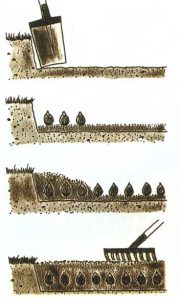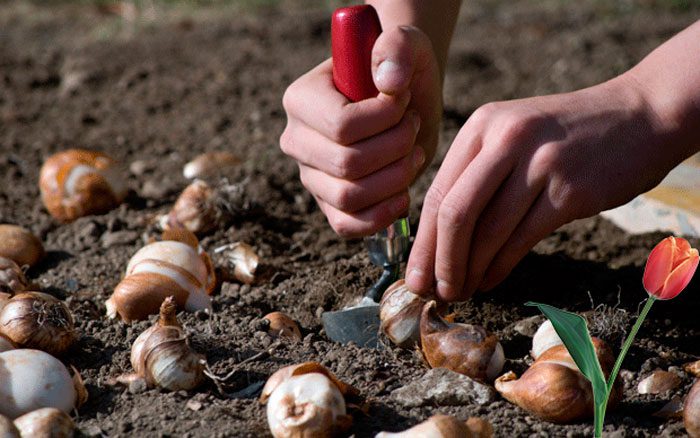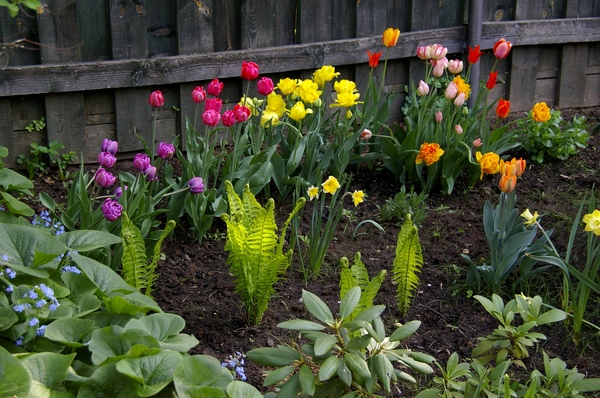With the arrival of autumn, all gardeners begin to think about spring when tulips begin to bloom. After all, the most suitable time for planting tulips is autumn. If planted correctly, these lovely flowers in the fall, their delicate buds will bloom in the spring. If the rules for planting bulbs are violated, problems will arise, which will be very difficult to eliminate.
Time to board
As a rule, in late September - early October, the soil temperature drops to 7-10 ° C. This is the ideal time to plant tulips. It should be borne in mind that for the formation of the root system, the bulbs will need from three weeks to a month. And the weather in autumn is unstable. If the bulbs are planted late in November, they will need good shelter for the winter (foliage or spruce branches).
Early as well as late landing has its drawbacks. Planting tulips too early will delay the rooting process. In addition, due to the high temperature, the bulbs are susceptible to a disease called fusarium. When it is warm outside, the bed is well overgrown with weeds. In the spring, they will start to grow and will interfere with the growth and strength of tulips. If the bulbs are planted too late, there is no guarantee that the root system will form. They can freeze or rot. The tulip will not bloom well, the new bulbs will be small and of poor quality.
Bulbs planted in the spring start blooming later than those planted in the fall. For tulips to germinate well, they need a cooling period in order to form substances that contribute to the active development of plants. In natural conditions, wild tulip species germinate when the snowdrifts melt. Experienced gardeners take this into account by growing these unpretentious plants in their flower garden.
Site and soil selection
Modest flowers prefer well-lit, sunny areas. They must be protected from the wind, as they are afraid of drafts. Any cultivated garden soil is suitable for these beautiful flowers. The main thing is that it is loose and permeable. The best option would be sandy loam or loamy soil. A soil rich in humus is perfect. Heavy clay soils are not a problem. They can be improved by adding peat or compost.
Good drainage is essential when planting tulips. Groundwater should not stagnate in the soil during the cold season. Otherwise, the bulbs will get wet and freeze. If the site is waterlogged, it is better to break high beds.
Slightly alkaline or neutral soils are suitable for tulips. Acidic soils are not suitable for them. It is very important that the soil settles before planting.To do this, it is carefully dug to a depth of 25-30 centimeters (preferably in a month).
So that perennial weeds do not interfere with the flowers, before digging up the area, it is treated with a special Roundup agent. The plant begins to absorb nutrients from March, so you should ensure direct access to them in advance. Organic fertilizers are applied to the soil a year before planting tulips. Fertilizer such as tulip manure is contraindicated.
Spring feeding
 Tulips need mineral nutrients. It is best to feed them with special complex fertilizers that are intended for onion plants. They contain a complex of essential trace elements and nutrients. If it is not possible to purchase a complex fertilizer, ash, bone meal, superphosphate, bird droppings, nitroammofoska are added to the soil before planting.
Tulips need mineral nutrients. It is best to feed them with special complex fertilizers that are intended for onion plants. They contain a complex of essential trace elements and nutrients. If it is not possible to purchase a complex fertilizer, ash, bone meal, superphosphate, bird droppings, nitroammofoska are added to the soil before planting.
Before you start planting tulip bulbs, they are thoroughly examined. Planting material must be of high quality. Large, healthy bulbs are considered suitable. Sick, rotten bulbs are not suitable for planting. They will infect neighbors and in the spring you can be left without flowers. Before planting, the bulbs must be treated with a 0.5% solution of potassium permanganate or soaked in an antifungal agent.
Immediately after pickling, the bulbs are planted in the ground. If time is missed, the roots will become brittle due to the swelling of the bulbs. For planting, it is worth preparing furrows with a depth of 10-15 cm. The spacing between the bulbs should be 9-10 cm. If the soil is heavy, the bulbs are planted at a shallow depth. Conversely, on light soils, they should be planted deeper. Planting depth also depends on the tulip variety. The bulbs belonging to the extra-class varieties are planted to a depth of 15-18 cm. The planting depth of the II and III bulbs is 12 cm. Children are planted very shallow.
In dry soils, furrows are poured abundantly with water. Fertilizer for bulbous plants is applied to the bottom of the hole, provided that it was not introduced for digging. Then they cover it with a thin layer of sand. After that, at a distance of 8-10 cm, the bulbs are laid out with the bottom down. To avoid damaging the swollen roots, the bulbs must not be strongly pressed into the soil. For even flowering, large bulbs are planted in the center, and small ones on the sides.
The bulbs are lightly powdered with ash, sprinkled with sand on all sides and covered with soil. To get a tulip pattern, it is worth removing the top layer of soil from the entire plot and leveling the surface for planting. Having laid out the bulbs in a certain order, they are covered with earth, which was removed before. To make it easier to care for flowers, tulips are planted according to varieties.
To the same place tulips can be returned after 4 years. To avoid cracking of the soil during the period of stable frosts, a thin layer of peat is introduced into it. It will not only protect the plant from freezing, providing the bulbs with an even temperature, but also preserve the root system, reduce the growth of weeds. The soil will remain loose. When spring comes, the peat is not harvested.















thank